This week’s group meeting’s talk on ‘Strategies in Synthetic Planning’ raised a number of interesting points for discussion, but I wanted to put just one to my readers and the online synthetic community: what’s your favorite total synthesis?
Strangely, the question actually put to the group was a bit less subjective—the word "best" was used, as if there's a single right answer—but I've found that whenever conversations along these lines occur, that there's a wide spectrum of answers. The history of total synthesis—while rather short compared to many branches of science—is still vast, and there’s a lot of great work out there that I'm not sure can (or should) be ranked on some absolute scale. One problem is that there are just too many criteria on which syntheses can be judged (length, creativity, yield, scalability...); although I’ve heard several people liken completing a total synthesis to running a marathon, there’s much more to it than just doing it fast! I remember Rob Stockman introducing Andrew Phillips while chairing a session at a conference a few years ago by comparing the styles of different synthetic chemists to those of different painters, and I think that the analogy is a good one.[1] Looking back across the body of work produced by the synthetic community it’s easy to identify the “old masters”, but few would be prepared to rank them in order of greatness; you’d just as well choose a "best" fruit or color.[2] Sure, there are now a bunch of metrics for assessing synthesis on everything from atom economy to percentage ideality,[3] but I’m pretty sure that’s not how K. C. Nicolaou decided what to put in his Classics in Total Synthesis series and I think it’ll be a while before we see a really elegant route to a target designed by a computer.
Anyway, that’s probably enough pontification for one blog post, so here are a few of my favorite syntheses and a few that came up in recent conversations—please add yours and your thoughts in the comments!
1. Reserpine (R. B. Woodward, 1956)
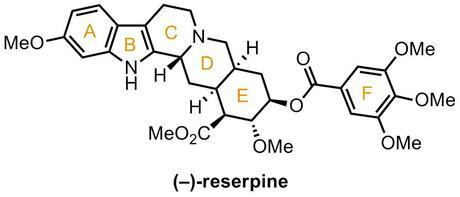
This is probably not a surprise to long-time readers
Described by my boss as “maybe top 20”, I still love this synthesis for its masterful use of substrate control, precisely applied by a young R. B. Woodward to rapidly build up a paradigm-shifting amount of complexity using nothing but the kind of common reagents you’d find in any undergraduate lab. In addition, the paper itself is beautiful, makes good use of footnotes and has an incredibly detailed experimental section. The full paper also coined the common terms “convex face” and “concave face” in the context of fused rings and was—to my knowledge—first to include copies of (IR) spectra for every compound. And in Tetrahedron no less! More information can be found in just about any book on ‘classic’ total synthesis, or you can read my take here.
If you’re pushed for time, just check out Woodward’s rapid construction of the stereochemically dense E-ring below, which remains impressive even by today’s standards and was able to comfortably provide the dozens of grams of material necessary to complete the group’s studies.
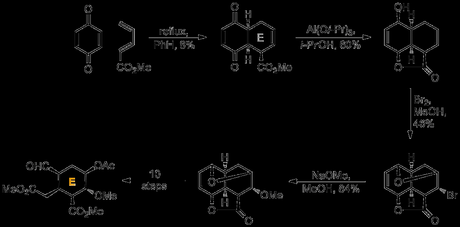
That's some mighty fine substrate control!
2. Daphnilactone (Heathcock, 1989)
J. Am. Chem. Soc., 1989, 111, 1530
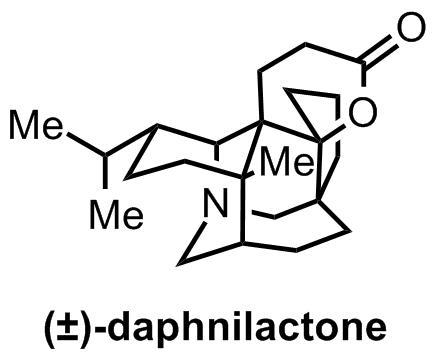
Daphnilactone, a typical Daphniphyllum alkaloid
It’s difficult to choose just one Heathcock synthesis as his work with the alkaloids of the Daphniphyllum and Lycopodium families should be required reading for all synthetic chemists, but I think daphnilactone is perhaps my favorite.[4] For further reading on Heathcock’s work in this area (from the man himself), see Angew. Chem. Int. Ed., 1992, 31, 665.
As the synthesis is pretty short, and reading the original paper is quite hard work, I've shown it below. The route began with a-alkylation of the dienonate generated from the starting ester with geranyl iodide. The ester was then reduced and the resulting alcohol was acylated with the tribromide shown—itself surely prepared by a Hell–Volhard–Zelinsky reaction. A clever one-pot enol ether cleavage–Reformatsky–alkylation sequence then gave the tricyclic lactone–ether in good yield. The lactone was adjusted to the corresponding dialdehyde and this was then treated with ammonia in dichloromethane, effecting an awesome Diels–Alder/ene-reaction cascade to form the pentacyclic piperidine, effortlessly generating most of the molecule's compact core. Removal of the unwanted double bond by hydrogenation was followed by an unusual Grob-type fragmentation that ejected the THP oxygen as an alcohol, and oxidation of this to the corresponding acid, then treatment with formaldehyde completed the target.
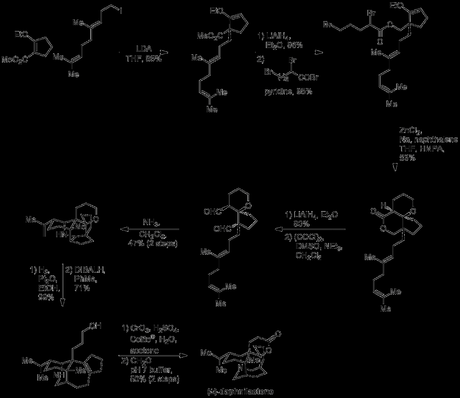
I can think of few other examples of such rapid generation of complexity and such masterful handling of a complex and congesting ring system!
3. Cedrene (Wender, 1981)
J. Am. Chem. Soc., 1981, 103, 688
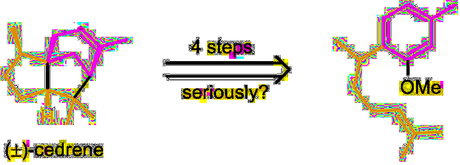
No explicit Me groups here because I'm recycling old images from the blog's distant past that I've lost the .cdx files for!
I guess this probably isn’t a serious contender in most people’s books, but it really blew my mind when I first saw it— and I still think that the meta-photocycloaddition is a breathtakingly creative disconnection for this ring system:
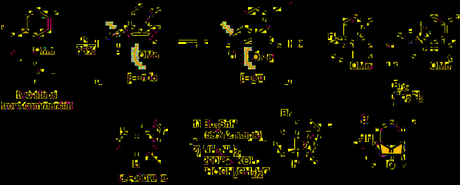
Wender's cedrene synthesis: surprisingly selective at the end
The thing I find most amazing is the sheer number of products that the reaction could have given, whereas only two were obtained. As I wrote in a while back:
Let's just think for a minute about what could have been: considering the intermolecular case of this reaction between a trisubstituted arene and an alkene fragment with a single chiral center then 168 possible products could be formed from this reaction. Tethering the alkene and performing an intramolecular reaction reduced this to 36 and when only the meta- outcomes were considered (a result determined by the electronics of system, among other factors) this was further reduced to 24 possible products. Model studies and careful consideration of the transition state then indicated that the actual number would be far fewer than that. The requirement for the sidechain methyl group in the starting material to end up β-disposed in the adduct was ensured by an A1,3 clash with the anisole methoxy group (see below). The reaction also showed a massive preference for the exotransition state which ultimately meant that only an inconsequential mixture of 2 vinylcyclopropane isomers were formed with all the stereogenic centres set in the correct relative sense. This mixture of products was not separated, but rather treated with bromine in dichloromethane to give a single bromoketone as the sole product.
That, coupled with the fact that no-one had ever used the meta-photocycloaddition reaction in total synthesis before at all; it had pretty much remained an academic curiosity since its accidental discovery by Bryce-Smith using the finest British sunlight at the University of Reading!
Random Thoughts
From previous conversations that I've had on this subject it seems that 1) few people pick syntheses from the past decade; and 2) that no-one ever picks anything over a certain length (say, ca. 20 steps).
With regard to the first point, I suppose that a lot of people will have been influenced by classes on classic synthesis throughout their undergraduate and graduate careers, as well as the focus given to the 'golden era' of synthesis in a lot of the books recommended as background reading for the field. I certainly don't think it's for a lack of interesting work published recently, although arguably the motivations for total synthesis today are often a bit different than they were when the syntheses above were performed. I definitely find it harder to pick a favorite synthesis from the past decade so here's a few; please add your favourites in the comments below. If I had to go with just one, I absolutely love Johan Mulzer's synthesis of Penifulvin A, which I blogged about way back in 2012. I was also really impressed with Stoltz’s cyanthiwigin work, as well as some of the recent MacMillan group efforts in alkaloid synthesis, and several of my colleagues have expressed love for Sarah Reisman’s synthesis of maoecrystal Z (covered by Tot. Syn. here). More recently, I really enjoyed Baran’s ingenol synthesis, especially in view of previous synthetic struggles with members of the family. And from outside the US, Yang’s somewhat controversial synthesis of maoecrystal V and Aggarwal’s clever prostaglandin synthesis are my pick of the bunch.
Regarding length, although they're certainly milestones in the field, I’ve never heard taxol, palytoxin, brevatoxin A, ciguatoxin B, Vitamin B12 or any other really large molecules chosen. I suppose that this is because when working around with such large targets a certain degree of “non-ideal” steps like non-strategic redox adjustments and protecting group jiggery-pokery become inevitable, and these features detract from the overall sexiness of the routes. Certainly, the amount of man hours level of technical skill are breath-taking,[5] but the majority of transformations are usually quite pedestrian. Sometimes it's possible to get excited by the cleverness of the over-arching strategy,[6] but the retrosyntheses are often (by necessity) unadventurous, because with such large fragments and such long sequences, everyone wants as much predictability as possible. I'll finish by saying—as it's bound to come up—that K. C. Nicolaou’s on-going campaign towards maitotoxin is of as much interest to me as current efforts to beat the world record (of 109) for “most living bees held in the mouth”; I’m pretty sure it will happen, but I’m not certain what we’ll learn from it, and I’ll be mightily glad that I wasn’t involved.[7]
Etc.
- If I recall correctly, Andy was likened to Rembrandt, for his large, complex works.
- But grapefruit is objectively the worst.
- My PhD supervisor would have said that ‘ideality’, like pregnancy, is rather a Boolean variable: you either are, or you’re not…
- Alternatively, KCN went with methyl homosecodaphniphyllate in his first Classics in Total Synthesis book. Heathcock was prolific in this area and developed a general strategy that enabled broadly similar syntheses of a great many Daphniphyllum alkaloids.
- For details of the current mouth-bee-holding record by professor (!) Norman Gary, see http://www.agonybooth.com/agonizer/Norman_Gary_Interview_2005.aspx
- I would say this was probably true of Woodward's chlorophyll synthesis, and to an extent, some of KCN's work on the brevetoxins.
- Some flavor of the trials and tribulations of such projects, and the pertinacity and single-mindedness required to complete them is conveyed through Woodward’s lectures on his B12 synthesis, which carry a lot more emotion and passion than a full paper ever could (not that I wouldn’t like to see one at some point!).
